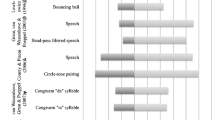Abstract
Using our novel methodology for quality evaluation of long duration multimedia content, the effect of the time dimension on quality ratings and user responses is investigated. Particularly, the influence of audio artifacts related to different compression rates on participants’ reactions to quality changes over extended periods of time is examined. Results of the first study suggest that participants’ quality expectations are rather constant throughout the entire duration of the 30-minute long clip, which also holds for subjects’ reaction time to quality degradations. Furthermore, it turns out that the test persons are more sensitive to quality changes when they are able to influence the quality themselves. In addition to the first study, two experiments were conducted in which cross-modal effects between the visual and auditory modality were investigated. The findings indicate that it is significantly easier for participants to discover quality changes when impairments are introduced in both the auditory and visual modality at the same time than when distortions occur in the audio or video domain solely.









Similar content being viewed by others
References
Lodge, N. K., Wood, D. (1994). Subjectively Optimizing Low Bit-Rate Television. In: Proceedings of the IEEE International Broadcasting Convention IBC 94. Amsterdam, pp. 333–339.
Aldridge, R., Davidoff, J., Ghanbari, M., Hands, D., & Pearson, D. (1995). Measurement of scene-dependent quality variations in digitally coded television pictures. In: IEEE Proceedings Vision. Image and Signal Processing, 142(3), 149–154.
ITU-R Recommendation BT.500-7. (1996). Methodology for the subjective assessment of the quality of television pictures. Geneva: International Telecommunication Union.
Bouch, A., Sasse, M. A. (2000). The case for predictable media quality in networked multimedia applications. In: Proceedings of ACM/SPIE Multimedia Computing and Networking (MMCN’00). San Jose, pp. 188–195.
Nemethova, O., Ries, M., Dantcheva, A., Fikar, S. (2005). Test equipment of time-variant subjective perceptual video quality in mobile terminals. In: International Conference on Human Computer Interaction (HCI), Las Vegas.
Buchinger, S., Robitza, W., Nezveda, M., Sack, M., Hummelbrunner, P., Hlavacs, H. (2010). Slider or glove? Proposing an alternative quality rating methodology. In: Fifth International Workshop on Video Processing and Quality Metrics for Consumer Electronics (VPQM). Scottsdale, Arizona.
Liu, T., Cash, G., Narvekar, N., Bloom, J. (2012). Continuous mobile video subjective quality assessment using gaming steering wheel. In: Sixth International Workshop on Video Processing and Quality Metrics for Consumer Electronics (VPQM). Scottsdale, Arizona.
Borowiak, A., Reiter, U., Svensson, U.P. (2012). Quality evaluation of long duration audiovisual content. In: The 9th Annual IEEE Consumer Communications and Networking Conference—Special Session on Quality of Experience (QoE) for Multimedia Communications. Las Vegas, pp. 353–357.
Borowiak, A., Reiter, U., Tomic, O. (2012). Measuring the quality of long duration AV content—analysis of test subject/time interval dependencies. In: EuroITV 2012 – Adjunct Proceedings. Berlin, pp. 266–269.
Chen, K. T., Wu, C. C., Chang, Y. C., Lei, C. L. (2009). A crowdsourceable QoE evaluation framework for multimedia content. In: Proceedings of the 17th ACM international conference on Multimedia. New York, pp. 491–500.
L.A.M.E (Lame Ain’t an MP3 Encoder) - The Hydrogenaudio recommended MP3 encoder, http://lame.sourceforge.net
Yang, X., Tan, Y., Ling, N. (2006). Rate control for H.264 with two-step quantization parameter determination but single-pass encoding. In: EURASIP Journal on Applied Signal Processing. pp. 1–13.
Wang, H., Qian, X., Liu, G. (2010). Inter mode decision based on just noticeable difference profile. In: Proceedings of 2010 IEEE 17th International Conference on Image Processing. Hong Kong.
ITU-T. (1998). Subjective audiovisual quality assessment methods for multimedia applications P.911, International Telecommunication Union.
ITU-R Recommendation BS.1116 (rev. 1). (1997). Methods for the subjective assessment of small impairments in audio systems including multichannel sound systems. Geneva: International Telecommunication Union.
Huber, R., Kollmeier, B. (2006). PEMO-Q—A new method for objective audio quality assessment using a model of auditory perception. In: IEEE Transactions on Audio Speech and Language Processing, Piscataway.
Holmes, N. P., & Spence, C. (2005). Multisensory integration: space, time and superadditivity. Current Biology, 15, 762–764.
Reiter, U., Korhonen, J. (2009). Comparing apples and oranges: Subjective quality assessment of streamed video with different types of distortion. In: Procedings of the First IEEE International Workshop on Quality of Multimedia Experience (QoMEX’09). San Diego, CA, USA.
Beerends, J. G., & De Caluwe, F. E. (1999). The influence of video quality on perceived audio quality and vice versa. Journal of the Audio Engineering Society, 47(5), 355–362.
Storms, R. L., & Zyda, M. J. (2000). Interactions in perceived quality of auditory-visual displays. Journal Presence: Teleoperators and Virtual Environments, 9(6), 557–580.
Acknowledgments
This study was performed within the PERCEVAL project, funded by The Research Council of Norway under project number 193034/S10.
Author information
Authors and Affiliations
Corresponding author
Rights and permissions
About this article
Cite this article
Borowiak, A., Reiter, U. & Svensson, U.P. Audio Quality Requirements and Comparison of Multimodal vs. Unimodal Perception of Impairments for Long Duration Content. J Sign Process Syst 74, 79–89 (2014). https://doi.org/10.1007/s11265-013-0777-8
Received:
Revised:
Accepted:
Published:
Issue Date:
DOI: https://doi.org/10.1007/s11265-013-0777-8




